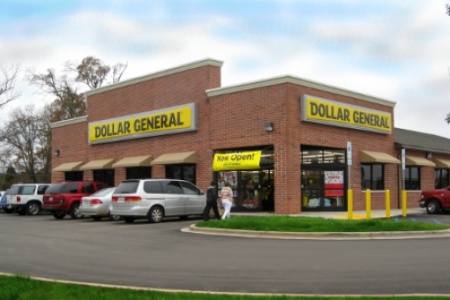Why Dollar General will keep its promise to build 1K stores this year
Just as struggling chains like The Limited, Sears and Macy’s are closing stores, one retailer is gearing up for the largest U.S. expansion program in recent memory.
Dollar General confirmed to Retail Dive it intends to move forward with its plan to build an unprecedented 1,000 new stores in 2017 — or, as a Buckingham Research analyst pointed out, about 2.5 stores per day.
Already in 43 states, this will bring Dollar General into 44 (with the addition of North Dakota) and continues its ongoing initiative to fill in spaces across the country the retailer has identified as fertile ground.
To many Americans it may seem the Goodlettsville, TN-based dollar store chain’s black and yellow sign is already a fixture in their neighborhood, and such observations are not without merit. Dollar General has more stores across the country than any other retail nameplate — 13,205 at last count. That compares to Wal-Mart at 5,229, Target at 1,803 and CVS at 9,600. Its toughest rival, Family Dollar, has 7,964 stores, and Family Dollar’s sister Dollar Tree has 6,320. By this time next year there will be about as many Dollar Generals in the U.S. as McDonald’s restaurants.
As Dollar General forges full speed ahead with its expansion plans, who should be on heightened alert? Pretty much any retailer that sells core, everyday consumable goods. Discounters, drug stores, supermarkets and other dollar store players are all a target for market share.
In 2015, Dollar General controlled 56.4% of the dollar store market, followed by Dollar Tree with 21.6% and Family Dollar with 14%, according to Nielsen data.
Dollar General’s model, a combination of low prices and convenience, has attracted enough shoppers to produce the cash flow necessary to fuel its rampant growth. A standard 7,300 sq. ft. Dollar General store costs about $250,000 to build, and pays for itself within 1.7 years, according to company reports.
In 2016, Dollar General opened 900 new stores on top of the 730 units opened in 2015. Meanwhile, the company has been retrofitting a bulk of mature stores into its latest DG16 format that features a new checkout area to ease congestion and presents more $1-priced products near the front. Always fine-tuning assortments, it has been expanding profitable departments such as perishables, health and beauty, party and stationery. Stores carry about 10,000 SKUs and Dollar General knows the direct profitability of each. On average, Dollar General’s prices are on par with discounters, 20% less than at grocery stores and 40% less than at drugstores, according to statements from the company.
A widening customer base has also helped spur Dollar General’s vast development. As CEO Todd Vasos told analysts at its 2016 investor day conference, the current economy “continues to create more of our core consumer each and every year,” according to a Seeking Alpha transcript of the event.
Along with its principal budget shoppers, Dollar General has been seeing more millennials and trade-down shoppers come through its doors.
Until the second quarter of 2016, Dollar General has consistently posted same-store sales growth. But it too has hit a slippery spot, with same-store sales softening in the last two quarters, hurt by price deflation in some food categories and a reduction of SNAP benefits among shoppers. To combat that, it has implemented lower prices on 450 key items in 17% of its store base in hopes of building traffic. As it determines what works and what doesn’t it may apply discounts elsewhere.
Still, overall financials remain impressive as net sales grew 5.9% to $15.98 billion for the nine months ended Oct. 28, 2016, with net income of $837 million up from $789 million from the year earlier period. Full-year 2015 net sales grew 7.7% to $20.4 billion, with net income of $1.7 billion, up from $1.07 billion.
Retailers like Dollar General need to have a physical space, because selling online isn’t really a financial option.
At a time when many retailers are closing physical stores and ramping up digital operations, off-price retail offers a healthy environment with room to grow. Robin Lewis, CEO of The Robin Report, a retail strategy publication, has long espoused there is room for more discount retail.
With increasing Kmart store closures removing shopping options, and the high price of gas causing travel challenges to get to the nearest Wal-Mart, a dollar store popping up in a neighborhood solves a problem.
While its primary model is its standard 7,300 sq. ft. store, Dollar General earlier this year revealed plans for a smaller more urban format, coined DGX, which will be around 3,400 sq. ft. It has also been learning about perishables categories with its handful of larger and fresh food oriented Dollar General Market and Dollar General Plus stores. Of the 1,000 stores coming in 2017, most will be its core box with 150 to 160 of the new smaller format.
In a simple phrase, that Vasos often repeats, he wraps up why the business model works: “In good times our customers have a little bit more to spend and in tougher times, they need us more.”




